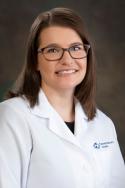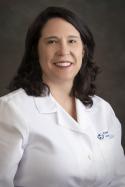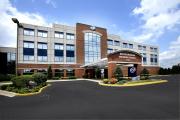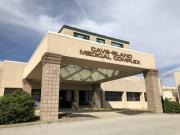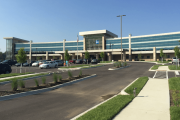Lymphoma
Lymphoma is a complex blood disease. So, if you or a loved one is diagnosed with lymphoma, you need a multidisciplinary team of experts who specialize in treating blood cancers. Here, you’ll have access to board-certified specialists who can diagnose and treat your specific type of lymphoma and will keep your unique preferences and treatment goals in mind. And because we’re a Comprehensive Community Cancer Program, we offer many of the same treatment options—and advanced technologies—you’d find at an academic medical center, just close to home.
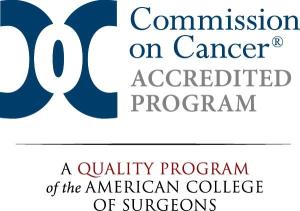
What is Lymphoma?
Lymphoma is a cancer that starts in the body’s white blood cells, called lymphocytes. There are two main types of lymphocytes: B lymphocytes, or B cells, that make antibodies to help protect the body from infection; and T lymphocytes, or T cells, that serve roles including destroying germs and abnormal cells in the body.
There are two types of lymphoma that commonly affect adults: Hodgkin lymphoma (HL) and non-Hodgkin lymphoma (NHL). Non-Hodgkin lymphoma is often referred to as simply lymphoma.
Both types typically start in the B lymphocytes. And both usually start in the lymph nodes, spleen, bone marrow, thymus, adenoids and tonsils, or digestive tract.
Hodgkin Lymphoma Types
There are two main types of Hodgkin lymphoma:
- Classic Hodgkin lymphoma (cHL) accounts for the majority of Hodgkin lymphoma cases in the United States. The cancerous cells in this type of cancer are called Reed-Sternberg cells.
- Nodular lymphocyte-predominant Hodgkin lymphoma (NLPHL) contains large cancerous cells called popcorn cells because of their appearance. This cancer usually starts in the lymph nodes in the neck and under the arm. It also tends to grow more slowly and is treated differently from cHL.
Non-Hodgkin Lymphoma Types
There are many types of non-Hodgkin lymphoma. The majority are B-cell lymphomas. The most common include:
- Diffuse large B-cell lymphoma (DLBCL) is the most common form of NHL in the United States. It usually starts in a lymph node in the chest, abdomen, neck or armpit. This type of cancer is usually fast-growing, but also typically responds well to treatment.
- Follicular lymphoma is a slow-growing lymphoma that usually begins in lymph nodes. While follicular lymphomas respond well to treatment, they’re generally hard to cure.
- Chronic lymphocytic leukemia (CLL)/small lymphocytic lymphoma (SLL): These closely related diseases only differ in where they begin. In CLL, most start in the blood and bone marrow. In SLL, most start in the lymph nodes or spleen. Both are slow-growing, although CLL is more common.
Lymphoma Risk Factors
A risk factor is something that increases your risk for developing a certain type of cancer. Some, like those related to genetics, you can’t change. But others, like risk factors related to lifestyle, you can.
Hodgkin Lymphoma Risk Factors
Risk factors of Hodgkin lymphoma include:
- Age, with young adults and older adults most at risk
- Family history
- Gender, with the disease occurring more often in men
- Past infection with Epstein-Barr virus
- Weakened immune system
Non-Hodgkin Lymphoma Risk Factors
Risk factors of non-Hodgkin lymphoma include:
- Age, with risk increasing as you get older
- Certain infections, such as those that weaken the immune system
- Exposure to certain chemicals, such as benzene
- Exposure to radiation
- Family history
- Gender, with the disease occurring more often in men
- Having an autoimmune disease, such as rheumatoid arthritis, celiac disease or lupus
- Having breast implants
- Obesity
- Weakened immune system
Lymphoma Symptoms
Since lymphoma symptoms are similar to those caused by other, less serious conditions, only a doctor can determine if what you’re experiencing is caused by cancer.
Hodgkin Lymphoma Symptoms
Some symptoms of Hodgkin lymphoma include:
- Drenching night sweats
- Lumps under the skin, usually in the neck, under the arm or in the groin
- Fatigue
- Itchy skin
- Loss of appetite
- Persistent fever without an infection
- Unintentional weight loss
Non-Hodgkin Lymphoma Symptoms
Some symptoms of non-Hodgkin lymphoma include:
- Chest pain
- Easy bruising or bleeding
- Enlarged lymph nodes
- Fatigue
- Frequent infections
- Shortness of breath or cough
- Swollen abdomen
- Unintentional weight loss
Diagnosing Lymphoma
Most people with lymphoma, either Hodgkin lymphoma or non-Hodgkin lymphoma, go to the doctor because they’re experiencing symptoms—most commonly, a lump that won’t go away.
To diagnose lymphoma, we’ll often perform blood and imaging tests, such as an X-ray, CT scan, ultrasound, PET scan or bone scan. We’ll also perform a biopsy to remove some or all of a lymph node or tumor to study it closely.
Treating Lymphoma
Our multidisciplinary cancer team will work together, and with you, to create a personalized treatment plan. Your team may include medical, surgical and radiation oncologists, hematologists, dietitians, genetic counselors and other medical professionals.
And we may treat Hodgkin lymphoma differently from how we treat non-Hodgkin lymphoma.
Hodgkin Lymphoma Treatments
For Hodgkin lymphoma, we often use:
- Chemotherapy to treat the cancer.
- Radiation therapy after chemotherapy.
- Monoclonal antibodies to help fight infection.
In addition, we may recommend other forms of immunotherapy, such as the drugs nivolumab and pembrolizumab, as checkpoint inhibitors to treat people whose cancer has grown or returned after other treatments were used.
Non-Hodgkin Lymphoma Treatments
For non-Hodgkin lymphoma, we’ll typically use chemotherapy as the main treatment. But we also combine it with other treatments, such as radiation or immunotherapy. We may use targeted therapy drugs if standard chemotherapy doesn’t work.
We may use radiation therapy as the main treatment for some types of non-Hodgkin lymphoma. This may be the case for cancers that are found early, or for lymphomas that are more aggressive or have advanced.







